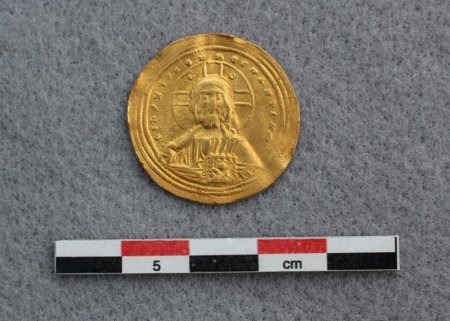'Very rare' ancient coin depicting Jesus uncovered in Norway

A "very rare" gold coin depicting the image of Jesus Christ that may have come from the Byzantine Empire roughly 1,000 years ago was recently discovered in Norway.
A metal detectorist found the artifact in the mountains of Vestre Slidre, over 1,600 miles from Istanbul, Turkey, formerly known as Constantinople, which served as the capital of the Byzantine Empire.
According to a statement from the Innlandet County Municipality in Norway, the coin is known as the Byzantine histamenon nomisma.
On one side, the coin displays Christ holding the Bible. The other side features an image of what researchers believe were rulers of the time, Basil II and Constantine VIII, who were brothers and co-emperors of the Byzantine Empire from 962 to 1025.
"The coin is unique in the Norwegian context," the Innlandet County Municipality stressed in its statement, according to Google Translate. "It has held up exceptionally well. The coin appears largely unchanged from when it was lost, perhaps a thousand years ago."
According to the statement, the coin was minted sometime between 977 and 1025 AD and featured a dotted, triple border.
The coin has two inscriptions, one in Latin which says: "Jesus Christ, King of those who reign." The other inscription is Greek: "Basil and Constantine, emperors of the Romans."
Municipality officials can only speculate about how the coin made it to Norway.
During that time, Harald Hardråde was the emperor's bodyguard. He later became king of Norway, according to the Archaeological Institute of America. Speculators question if the coin could have been part of Hardråde's salary, which he brought home during a trip home circa 1034.
Three emperors died during Hardråde's time in Byzantium, and it was customary for bodyguards to loot the palace after a king had died, according to the statement from the municipality.
"The treasures he acquired during his time as part of the emperor's guard in Constantinople, he sent to Prince Yaroslav in Kyiv. Among other things, the taxes were to contribute to a dowry, so that Harald could marry one of Jaroslav's daughters; Elliptical," the Municipality reported.
According to municipal officials, princes of Kyiv had familial ties to the emperors of Byzantium. Basil II was Queen Ellisiv's great-uncle.
"We know that Valdres was part of the Bjørgvin diocese until 1125. And one of the older traffic routes is called Bispevegen. It is not impossible that the coin was lost by one of the clergy on their travels," the municipality's statement adds.
Another explanation is that the coin arrived in Norway via the salt trade.
"The old trade routes, the salt roads, were based on trade in salt from Western Norway, so it is also possible that the coin entered into a good trade between salt and herring from the west, and iron ingots, reindeer skins and antlers from the east."
The location of the finding will not be investigated until 2024 because the coin was found in late fall. Researchers are still in the decision-making process of how to approach examining the site.
"We cannot currently say more about the discovery site than that it is a beach zone. Cultural Heritage in Innlandet County generally does not recommend detector searches in outlying areas," Innlandet County Municipality said.
"In the beach zone, there is usually a lot of movement in the masses and less danger of coming across untouched cultural monuments. We take this opportunity to refer to our guidelines for metal detecting."
Nicole Alcindor is a reporter for The Christian Post.






















